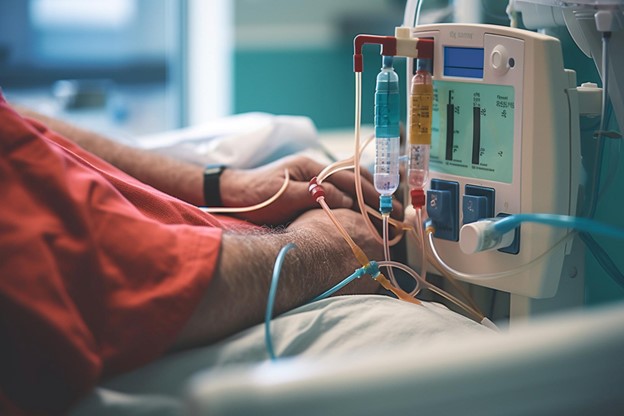Kidneys play an important role in keeping our bodies healthy. They’re like a filter for the blood, getting rid of harmful substances. But when they fail, it becomes a serious issue. That’s where hemodialysis comes in. This blog aims to help you understand the hemodialysis process explained, a lifesaver for those with kidney troubles. Early detection and quick treatment can make a big difference. By catching problems early, treatments like hemodialysis can start sooner. This not only helps in managing the condition better but also prolongs life and enhances its quality. So, let’s dive deep into this critical topic about kidney health.
Kidneys: The Unsung Heroes of Filtration
Our kidneys do a lot more than we might think. They’re like two tiny powerhouses tucked in our lower back. They filter our blood, removing waste and balancing fluids. When they don’t work well, toxins and fluids build up, leading to serious health issues. It’s like a clogged filter in a car engine—it needs fixing or the car won’t run smoothly. When kidneys falter, alternate methods, like hemodialysis, step in to keep things running smoothly. Hemodialysis helps filter and purify your blood using a machine. This process keeps you healthy even when your kidneys are not up to the task.
Hemodialysis Unplugged: Simplifying the Process
Hemodialysis is a vital treatment for people with failing kidneys. It’s like an external kidney that filters the blood. This procedure is vital for anyone with acute kidney problems. Renal replacement therapies like this help sustain life. During hemodialysis, blood is cleaned using a special machine called a dialyzer. This machine removes waste and extra fluid.
The hemodialysis process explained in simple terms is about cleaning the blood when kidneys can’t. Understanding this helps patients make informed health decisions. It’s a crucial part of managing severe kidney issues and enhances life quality significantly.
Hemodialysis Step-by-Step: From Preparation to Conclusion
Let’s break down the hemodialysis preparation steps: – Check vital signs like blood pressure and weight. – Use a fistula, graft, or catheter to access the bloodstream.
During the session: – Blood is drawn out and passed through a dialyzer. – The dialyzer acts as a fake kidney to cleanse the blood. – After filtering, clean blood returns to the body.
The mechanical process of hemodialysis involves careful monitoring. Health professionals check everything from blood pressure to fluid levels, ensuring the patient stays safe during treatment. Understanding these steps helps reduce anxiety and boosts confidence in the procedure.
Exploring Types and Schedules of Hemodialysis
You have types of hemodialysis to choose from. The main options are: – In-center hemodialysis – At-home hemodialysis
Each has different hemodialysis schedule options. Typically, in-center happens three times a week. At-home dialysis can be more flexible, allowing adjustments to suit personal needs. Many patients also compare hemodialysis vs peritoneal dialysis to find the best fit. Both methods have pros and cons. Hemodialysis is often considered for those needing structured medical oversight, while peritoneal dialysis is more a self-care option.
Personal Experiences: What to Expect During Hemodialysis
When undergoing hemodialysis, expect some sensations. There might be itching, nausea, or lightheadedness. Sessions can last about 3 to 5 hours and occur several times each week as dictated by the hemodialysis schedule options. Treatment frequency integrates into daily life, affecting work and other activities. Post-session care is vital to stay healthy. This involves: – Eating a balanced diet – Monitoring fluid intake – Taking any prescribed medications
Each stage involves adjustments, but many find a rhythm that works over time. Health professionals can offer guidance and support throughout.
Benefits and Limitations of Hemodialysis
Hemodialysis significantly enhances life quality and extends life for many. However, it comes with limitations and side effects. Some possible issues include low blood pressure, muscle cramps, and fatigue. It’s essential to set realistic expectations about what this treatment can achieve, balancing the positives against the drawbacks for a healthy outlook.
Embracing Life on Hemodialysis: Adapting for Better Health
Adapting lifestyle and diet is crucial for those on hemodialysis. Staying healthy involves: – Reducing salt and potassium in your diet – Following a tailored meal plan – Getting proper exercise
Support from a healthcare team and connecting with community groups can make a big difference. Interactive communication with medical providers ensures care is well-suited to personal needs. It’s all about working together to maintain a good quality of life despite the challenges.
Innovations and Preventive Strategies in Kidney Health
The world of kidney health is ever-evolving. Advances in hemodialysis technology make treatment more effective and comfortable. Ongoing research in kidney therapies promises even better outcomes in the future. Preventing kidney disease involves regular check-ups, healthy eating, and staying hydrated. Awareness and early action can make a huge difference in managing kidney health troubles.
Conclusion: Empower Yourself with Knowledge
Understanding hemodialysis’s role is key to managing chronic kidney issues. Knowledge empowers patients and families, equipping them to make informed decisions about care. Knowing what’s involved in your care plan turns fear into action. By proactively learning about medical procedures, individuals take control of their health journey. It’s about gaining confidence and understanding how essential practices like hemodialysis can positively impact lives.

